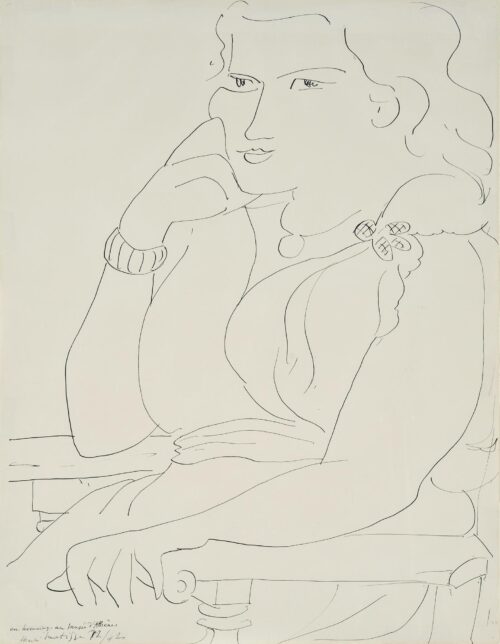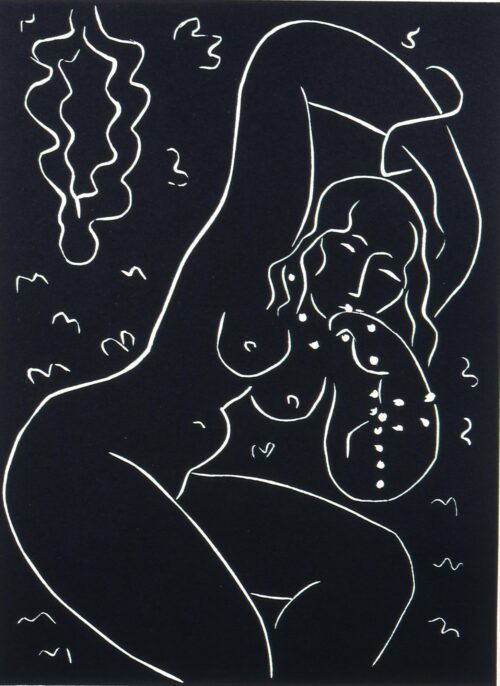
Matisse Henri (1869 - 1954)
Seated Female Figure, 1942
He initially studied law. His first contact with art was when he took drawing lessons at the Ecole Quentin Latour to escape from the routine drudgery of his work. In the winter of 1889, during a long period of convalescence, he became involved with painting and the next year settled in Paris. He attended the Julian Academy, at the studio of a well-known painter of the time. Bougereau, and also took lessons at the Ecole des Arts Decoratifs.
Gustave Moreau invited him to attend his studio at the Ecole des Beaux Arts, to which Matisse was accepted in 1895. The inventive and inspired teaching of Moreau was based more on the rendering of emotion and imagination, than the reproduction of reality. Until 1896, when Matisse showed his work at the Salon of the Nationale Societe des Beaux Arts his works displayed no outstanding differences from those of his fellow artists.
In 1900 he worked with Marquet on the decoration of the Grand Palais. Together with Rouault and Derain he presented his works at the Salon d’ Automne in 1903 and the next year he had his first solo exhibition at the Vollard Gallery.
1905 proved to be a year of decisive importance for the development of his work. At the Salon d’ Automne he exhibited, along with Marquet, Vlaminck and Dufy, works noted for their colors. This was the beginning of the Fauvist group which provoked a powerful critical response.
As a reaction to the early Cubist works, Matisse did paintings with intense and pleasant colors. His first contacts with Muslim culture came about through an exhibition that was organized in Munich in October 1910, and this led him to travel to southern Spain, Morocco and Moscow, a trip which lasted for many months. In 1912 he returned to Morocco and worked there for a year. In the works from this Moroccan period his contact with nature is renewed and there is a rather dreamy atmosphere to it, but coupled with intense luminosity and a wealth of color.
Matisse did come to accept certain of the cubist viewpoints and adopted those elements which he considered to be compatible with his own elements which he considered to be compatible with his own personal convictions in regard to painting. He was also involved with engraving. From 1914 on, his work began to be more austerely organized.
Starting in 1918 he spent longer and longer periods in Nice. In the works from this period, the female figure becomes the dominant one. Drawings, paintings, sculptures and engravings study in depth the structure of the female body and the rendering of its volumes. Matisse then turned toward the Impressionists, visited Renoir and most probably Monet. He also worked with Diaghilev on a ballet, with music by Stravinsky. His works became quite popular and the Museum of Luxembourg in Paris bought one of them for its collection. His exhibition in 1924 at the Bernhim-Jeune Gallery was an enormous success. During the period 1924-1930 retrospectives were also organized in Copenhagen, Berlin, Paris, Basel and New York and the first monographic studies of his work were published.
At the beginning of the Thirties he took his first long trip to Tahiti with stops along the way in New York and San Francisco and this was followed by a second trip to New York, as a member of the critical committee for the selection of the Carnegie Prize. The trip to Tahiti turned out to be rather a disappointment, but the impressions he took away would come to play a definitive role in the final decade of his life while a the same time he drew inspiration from the atmosphere in New York.
In 1933 he became deeply engaged with the illustration of the poems of Mallarme and also began the studies fro the large wall painting that he Barnes Foundation had commissioned him to build. This commission would occupy him in the coming years and would achieve its final form in the work Dance II. The design acquired even greater significance for his work at the end of the decade for his aim was to enclose in the line the personality of the model. The color was used to place emphasis on the design.
In 1941 Matisse underwent a series of serious operations which created major problems for him, making it difficult fro him to move about. Not being able to travel any longer he fashioned a studio for himself in Nice. For the following two years he devoted himself exclusively to drawing, because his natural forces were not adequate fro him to begin painting again. From that period is dated the large number of drawings and many book illustrations. The most important of these is the album Jazz with prints made of very strong colors, the outcome of a long process of cutting out shapes from paper. These works are of no less importance than his paintings. He began to paint again in 1942, with the female body as his subject once more. For a time he moved to the neighboring town of Vence. In 1945, the Nationale Musee d’ Art Moderne enriched its collections with many of his works. In 1946 he became involved with two large orders with Oceania as the subject, using the cut-out technique here as well. In these works, which tend more and more toward abstraction, can be seen the memories from his trips to Tahiti at the beginning of the Thirties.
The large design for the decoration of the church of Chapelle de la Rosaire in Vence, which occupied him from 1948 to 1951, was a summary of all the principles of his work, that is: drawing, light, color, painting and sculpture, all of them cooperating for the realization of an architectural conception which is animated by light.
The large dimension of his final works led to the designing of ceramic elements which were destined to be decorations used as wall hangings. His final work was the design of a vitrine.
He was one of the true innovators and rejuvenators of twentieth century pictorial language.

Seated Female Figure, 1942

Bathing woman with necklace, 1940

We use cookies to make our site work properly, to personalize content and ads, to provide social media features and to analyze our traffic. We also share information about how you use our site with our social media, advertising and analytics partners. Read the Cookies Policy.
These cookies are necessary for the website to function and cannot be switched off in our systems. They are usually only set in response to actions made by you which amount to a request for services, such as setting your privacy preferences, logging in or filling in forms. You can set your browser to block or alert you about these cookies, but some parts of the site will not then work. These cookies do not store any personally identifiable information.
If you disable this cookie, we will not be able to save your preferences. This means that every time you visit this website you will need to enable or disable cookies again.
These cookies tell us about how you use the site and they help us to make it better. For example these cookies count the number of visitors to our website and see how visitors move around when they are using it. This helps us to improve the way our site works, for example, by ensuring that users find what they are looking for easily. Our website uses Google Analytics for statistics reporting.
Please enable Strictly Necessary Cookies first so that we can save your preferences!